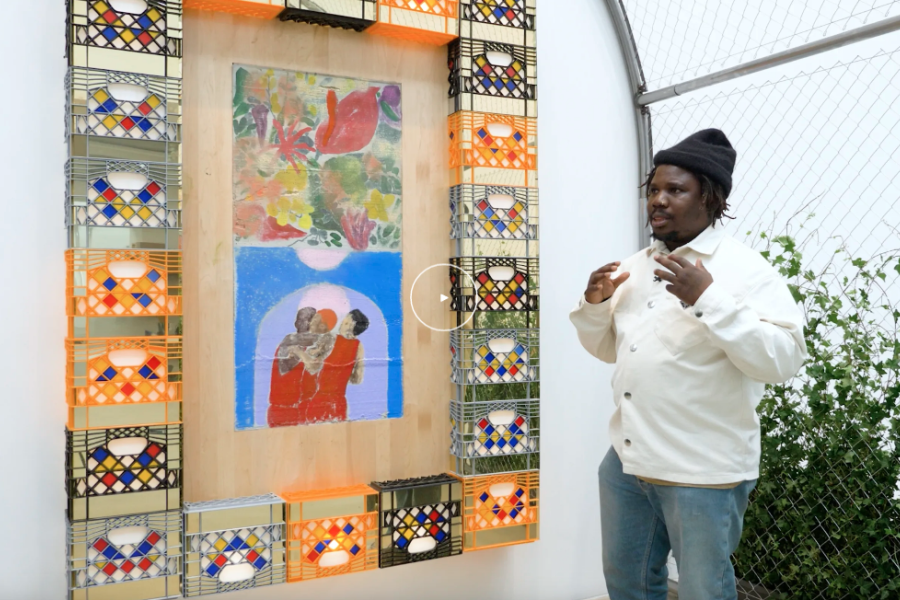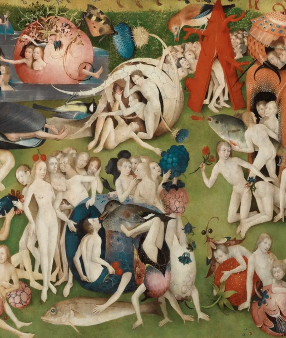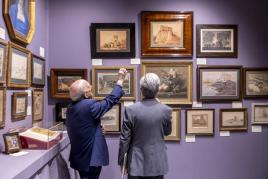Alvaro Barrington They Got Time: YOU BELONG TO THE CITY
 Alvaro Barrington, Watch a video of the exhibition in which the artist discusses his memories and his work - Mit freundlicher Genehmigung von: ropac
Alvaro Barrington, Watch a video of the exhibition in which the artist discusses his memories and his work - Mit freundlicher Genehmigung von: ropacWas: Ausstellung
Wann: 18.10.2023 - 27.01.2024
Wo: Paris, Frankreich
For They Got Time: YOU BELONG TO THE CITY, Alvaro Barrington takes over Thaddaeus Ropac Paris Pantin, transforming the luminous ex-factory building into a three-part installation. A monumental self-portrait of his years growing up in New York, the exhibition invites the visitor into an exploration of the artist’s personal and cultural memory: what Barrington describes as ‘a love letter to the nyc streetscape of my youth in the form of an art installation’.
Barrington fills the gallery with monumental handmade storefronts, made up of shutters in various mediums with rooms tucked behind chainmail curtains in which he installs his new series of works. He relates the installation overall to the ‘magic’ arcades of 19th-century Paris, as described by Walter Benjamin in his 1927–40 work of cultural criticism The Arcades Project, which formed the prototype for the modern storefront. Like in the memorable opening scene of the 1961 Blake Edwards-directed film Breakfast at Tiffany’s, in which Audrey Hepburn’s Holly Golightly looks longingly at the Tiffany’s window displays as the sun rises on 5th Avenue, Barrington encourages visitors to the exhibition to experience this sense of anticipation and aspiration for themselves as they look at his new works.
Streets are the dwelling place of the collective. [...] More than anywhere else, the street reveals itself in the arcade as the furnished and familiar interior of the masses. — Walter Benjamin, The Arcades Project, 1927–40
The exhibition unfolds across three rooms or ‘chapters’. Each one represents different aspects of the artist’s experiences growing up in New York as the son of Grenadian and Haitian migrant workers, channelled through both the imagery of his own personal history and through references that are part of the collective consciousness. The first, which he calls CHAINGING Room, relates to his memories of being a teenager in New York City, standing in front of closed shop shutters at dawn waiting eagerly for them to open so he could change his clothes to reflect how he wished to present himself to the world that day. The second chapter – THE BLOCK – meanwhile, stages a walk through Soho or along 5th Avenue, both through the buildings that line either side of the streets and through the collision of characters that the artist paints. ‘I bounce between my own biography and those of people around me’, explains the artist.
Barrington is continually expanding his constellation of references, inspirations and communities, while always acknowledging the formative role of art history in his practice. The new works on view reflect a cross-pollination of many such influences. Barrington channels the bather, an enduring theme in art history which he connects to Paul Cézanne, Pablo Picasso and Édouard Manet, among others, through hip-hop icons, basketball players and film stars. His new paintings include reworkings of David LaChapelle’s photograph of Tupac lying in the bath draped in jewels, and of Holly Golightly in her bathrobe. This chorus of figures comes together to tell the story of Barrington’s New York City, where sexuality, fashion and self-presentation meld with ideas of struggle and hope. As the artist says: ‘That’s what hip-hop is’.
Suddenly you’re afraid, and you don’t know what you’re afraid of. Don’t you ever get that feeling? [...] When I get it, the only thing that does any good is to jump into a cab and go to Tiffany’s. [...] Nothing very bad could happen to you there. — Holly Golightly, Breakfast at Tiffany’s, 1961
The exhibition culminates in a chapter Barrington entitles THE GARDEN: a play on words that brings together the excesses of the streets surrounding Madison Square Garden and Hieronymus Bosch’s The Garden of Earthly Delights (1490–1510). Dedicated to Barrington’s celebrated Basketball Paintings, this final space taps into the social significance of the sport, both to the artist during his own Brooklyn upbringing, and more widely across marginalised communities. Reflecting the memories and influences that come together in the exhibition, Barrington’s most recent works introduce new media to his established material language, bringing together elements that evoke luxury, like intricately carved wood, patterned leather given to him by the acclaimed luxury brand Alaïa and Tiffany-inspired stained glass lights, with laundry bags, milk bottles, concrete, cardboard and yarn: non-traditional objects and materials that reference his personal and cultural history.
Aspiration and possibility, especially among Black and marginalised communities, has always been at the heart of Barrington’s practice. Through recreating his own experiences of gazing into shop windows in New York City before school, the artist encourages visitors to the exhibition to look at his works with the same sense of longing and wonder he once felt. In doing so, the artist relays a narrative about not having and wanting, but also about the power of the objects we desire and consume to give us a sense of security, hope, or, as Barrington says, ‘participation’.
Special thanks to Alaïa for providing the leather used in selected works.
About the artistAlvaro Barrington studied at Hunter College in New York and the Slade School of Fine Art in London, later teaching at both of his alma maters, as well as at the Cooper Union in New York. The idea of the total installation has always been central to Barrington’s practice. His first solo museum exhibition, which opened the same year he graduated, was curated by Klaus Biesenbach at MoMA PS1, Queens, in 2017, and for it, he memorably recreated his own studio within the museum’s walls. His work has since been shown in numerous solo and group shows, including Alvaro Barrington: SPIDER THE PIG, PIG THE SPIDER, South London Gallery, London (2021); Mixing It Up: Painting Today, Hayward Gallery, London (2021); A Taste of Chocolate, Thaddaeus Ropac, London (2018), and through his ongoing Tt x AB collaboration with the painter Teresa Farrell. Barrington co-curated the exhibition Artists I Steal From with Julia Peyton-Jones at Thaddaeus Ropac, London in 2019, followed by his solo gallery exhibitions in Paris Marais (2021) and Salzburg (2022). In spring 2024, Alvaro Barrington will create a new installation for the Tate Britain Commission.
 Paul Cézanne. (This link opens in a new tab). The Card Players, 1894–1895 Oil on canvas 47.5 cm × 57 cm (18.7 in × 22 in) Musée d'Orsay. (This link opens in a new tab)., Paris - Mit freundlicher Genehmigung von: ropac / Galerie Thaddaeus Ropac Marais
Paul Cézanne. (This link opens in a new tab). The Card Players, 1894–1895 Oil on canvas 47.5 cm × 57 cm (18.7 in × 22 in) Musée d'Orsay. (This link opens in a new tab)., Paris - Mit freundlicher Genehmigung von: ropac / Galerie Thaddaeus Ropac Marais  Alvaro Barrington The Garden of Dreams, 90s Bulls (L), Oct 2023, 2023 Mixed media on concrete and maple in frame made of milk crates, glass, brass and lights - Mit freundlicher Genehmigung von: ropac / Galerie Thaddaeus Ropac Marais
Alvaro Barrington The Garden of Dreams, 90s Bulls (L), Oct 2023, 2023 Mixed media on concrete and maple in frame made of milk crates, glass, brass and lights - Mit freundlicher Genehmigung von: ropac / Galerie Thaddaeus Ropac Marais  Alvaro Barrington The Garden King of Spades Eddie (Y), Oct 2023, 2023 Acrylic, oil, enamel on aluminium in steel frame in steel arch with climbing ivy 185 x 120 x 5 cm (72.83 x 47.24 x 1.97 in) - Mit freundlicher Genehmigung von: ropac / Galerie Thaddaeus Ropac Marais
Alvaro Barrington The Garden King of Spades Eddie (Y), Oct 2023, 2023 Acrylic, oil, enamel on aluminium in steel frame in steel arch with climbing ivy 185 x 120 x 5 cm (72.83 x 47.24 x 1.97 in) - Mit freundlicher Genehmigung von: ropac / Galerie Thaddaeus Ropac MaraisOpeningWednesday 18 October 2023, 10pm—12amwith the artist present
18 October 2023—27 January 2024
Thaddaeus RopacParis Pantin69, avenue du Général Leclerc93500 PantinFrance
 Alvaro Barrington, untitled Pac (detail), 2023 Mixed media on concrete in gilded aluminium and carved wood frame 90 x 90 x 12 cm (35.43 x 35.43 x 4.72 in) Courtesy Thaddaeus Ropac gallery, London · Paris · Salzburg · Seoul Photo: Jonas Balsevicius © Alvaro Barrington - Mit freundlicher Genehmigung von: ropac / Galerie Thaddaeus Ropac Marais
Alvaro Barrington, untitled Pac (detail), 2023 Mixed media on concrete in gilded aluminium and carved wood frame 90 x 90 x 12 cm (35.43 x 35.43 x 4.72 in) Courtesy Thaddaeus Ropac gallery, London · Paris · Salzburg · Seoul Photo: Jonas Balsevicius © Alvaro Barrington - Mit freundlicher Genehmigung von: ropac / Galerie Thaddaeus Ropac Marais Hieronymus Bosch The Garden of Earthly Delights, 1490—1510 (detail) Oil on oak panels 205.5 cm × 384.9 cm (81 in × 152 in) Museo del Prado. (This link opens in a new tab)., Madrid - Mit freundlicher Genehmigung von: ropac / Galerie Thaddaeus Ropac Marais
Hieronymus Bosch The Garden of Earthly Delights, 1490—1510 (detail) Oil on oak panels 205.5 cm × 384.9 cm (81 in × 152 in) Museo del Prado. (This link opens in a new tab)., Madrid - Mit freundlicher Genehmigung von: ropac / Galerie Thaddaeus Ropac Marais Alvaro Barrington The Garden, Stained Glass for Rodman, Oct 2023, 2023 Stained glass 244 x 183 x 20 cm (96.06 x 72.05 x 7.87 in) - Mit freundlicher Genehmigung von: ropac / Galerie Thaddaeus Ropac Marais
Alvaro Barrington The Garden, Stained Glass for Rodman, Oct 2023, 2023 Stained glass 244 x 183 x 20 cm (96.06 x 72.05 x 7.87 in) - Mit freundlicher Genehmigung von: ropac / Galerie Thaddaeus Ropac MaraisCopyright © 2024 findART.cc - All rights reserved


